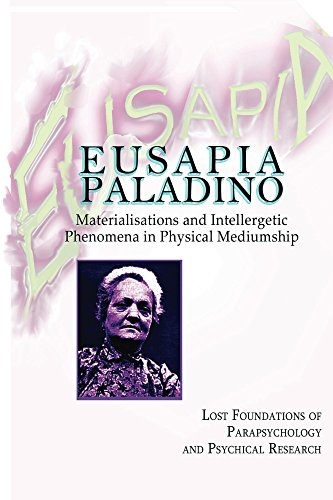
Reviewed by Tom Ruffles
Scott Dickerson has gathered a number of articles and book extracts about the Italian physical medium Eusapia Palladino (1854-1918) published between 1902 and 1917. From The Annals of Psychical Science he has taken ‘The Spiritistic and Spiritualistic Explanation of Mediumistic Phenomena’ by Ceasar de Vesme’, ‘A Contribution to the Study of Materialisations’ by Joseph Venzano, and ‘Biographical Sketch of Eusapia Paladino’ (actually mostly a profile by Cesare Lombroso’s daughter Paola Carrara, uncredited by Dickerson though her name appears in the text itself); a section of On the Threshold of the Unseen: An Examination of the Phenomena of Spiritualism and of the Evidence for Survival after Death, by William Barrett; one from Psychical and Supernormal Phenomena: Their Observation and Experimentation, by Paul Joire; the concluding remarks by Everard Feilding, W W Baggally and Hereward Carrington in their lengthy SPR Proceedings article ‘Report on a series of sittings with Eusapia Palladino’; an extract from Modern Spiritualism: A History and a Criticism, by Frank Podmore; another from After Death – What?, by Lombroso; and several newspaper reports covering Palladino’s visit to New York in 1909.
What is missing is any editorial gloss on the contents. Dickerson has not supplied an introduction, and no explanation why these selections were included while others were excluded. There is no bibliography for further reading, nor illustrations, and the transcription process has led to a number of typos. A minor one, but which sends warning signals, is in Carrington’s ‘Final Note’ to the sittings held in Naples in 1908. Carrington is quoted (p. 170) as saying ‘we lapsed back into skepticism’ but it seems odd that he would use the word skepticism, and of course in the original he writes ‘scepticism’. More seriously, Dickerson omits a table on the classification of phenomena and a short transcript by the stenographer in W W Baggally’s ‘Final Note’ without any indication he has done so. Footnotes in the original are silently integrated into the text (as I noticed also in the Podmore section, and presumably elsewhere – I checked Venzano’s ‘A Contribution to the Study of Materialisations’ and saw that the editor’s note was missing in Dickerson’s book, but there seemed little point doing a paragraph-by-paragraph comparison of all Dickerson’s versions with the originals). In the list of contents the page numbers are not in synch with the chapters, for some reason names of authors have been left off it (though they are on the back cover), and the date of Palladino’s visit to New York has been given as 1908; in any case no dates are supplied for the newspaper articles. Cheekily, Dickerson claims copyright of the volume, even though it is cobbled together from out-of-copyright works.
A contrast with Dickerson’s casual approach is provided by E J Dingwall’s elegantly edited Sittings with Eusapia Palladino & Other Studies, by Everard Feilding (1963). This volume includes the full Naples report, accurately transcribed with all tables, footnotes and diagrams present. The full report is of course also readily available in the SPR’s online library, as is the fierce debate the Feilding Report generated following the publication in 1992 of Richard Wiseman’s JSPR article ‘The Feilding Report: A Reconsideration’, not alluded to by Dickerson.
It is difficult to see who Dickerson’s target reader is supposed to be. For anyone needing an authoritative edition, this is not accurate enough. The general reader who wants to examine early reports may find the lack of contextualising information makes the selections confusing, as most of the authors, particularly contributors to The Annals of Psychical Science, assumed some background knowledge. This was potentially a good idea, to bring together a range of material illuminating Palladino’s remarkable mediumship, but the result would have been more usable with an editorial contribution and a less cavalier disregard for the originals. A definition of intellergetic would have been useful too. Anybody wishing to learn more about Palladino would be better employed starting with Carlos S Alvarado’s entry on her in the SPR’s Psi Encyclopedia. He provides a balanced assessment and an extensive bibliography.

